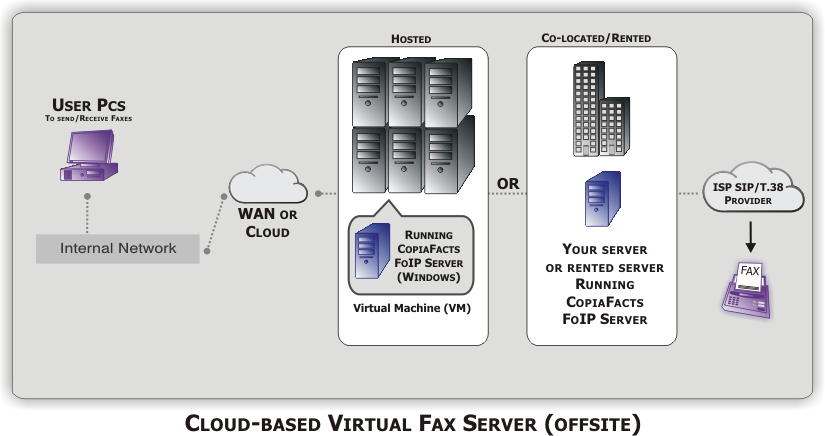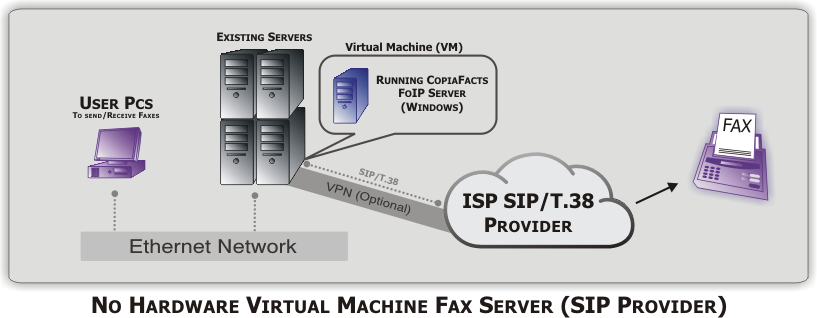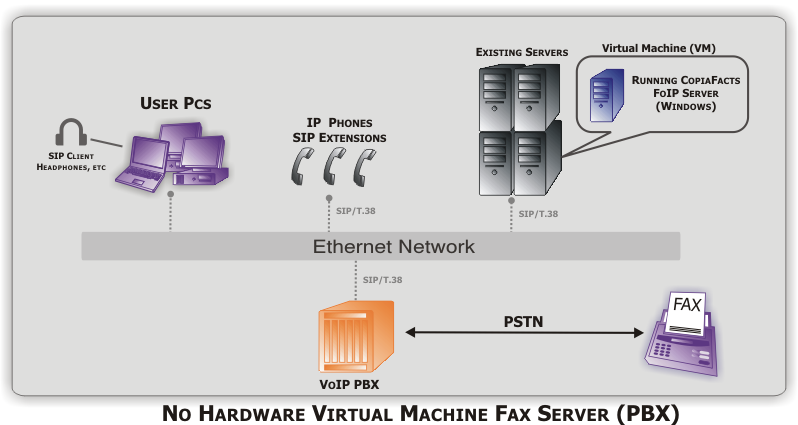FoIP faxing is the most common installation of faxing these days. Copia makes the confusing set of fax standards in an IP world understandable and our software works with all standard VoIP PBX from vendors such as Cisco, Asterisk, Alcatel-Lucent, Quintum, Avaya, ShoreTel and many more. Even if you don't currently use a VoIP phone system, Copia can virtualize your faxing infrastructure.
FoIP is possible with with no in-computer hardware (often referred to as "boardless"). Our systems install in hosted and co-located environments and fully support virtual machines.
FoIP Basics
Everything Fax Over IP starts with the SIP protocol. As the name would imply, Voice over IP (VoIP) networks are designed specifically for voice conversations. As such, most VoIP networks implement compression protocols that are tuned to voice, rather than to data (faxing is actually data transmission).
G.711
Used for voice calls due to high sample rate and call clarity. Faxing is not 'natively' supported.
G.729/G711 Passthrough
Unreliable for fax. Faxes fail with no clear reason, resulting in multiple resend attempts. Faxing is a real-time synchronous operation that, unlike traditional packet-based IP traffic, requires continuous handshake and verification of data packets with very tight timing tolerances.
Latency, jitter, and out of order/dropped packets occur frequently in traditional VoIP networks and are the enemies of fax sessions on IP networks.
T.38
T.38 accounts for timing and jitter issues encountered due to network congestion by spoofing the connection and allowing data transmissions to queue and catch-up on either side of the call.
Additionally, T.38 reduces the bandwidth needed to send faxes over an IP network and supports redundancy so missing/dropped/out-of-order are recovered and available.
Implementing Fax over IP with T.38
There are many network configurations that support a T.38 FoIP implementation. FaxFacts is flexible enough to fit into whatever environment makes the most sense for your company. Here are a few sample network scenarios to illustrate how to bring in a boardless solution.
Boardless and Hosted
Purpose: You want a complete fax solution off-site, virtualized or co-located in a secure location.
- Runs ANYWHERE!
- All virtual ports (i.e. no hardware) using BladeWare software.
- Configured to use a ISP directly for a SIP/T.38 session. All faxes are sent directly to the SIP provider. This is a digital SIP/T.38 connection so DNIS (DID) and CallerID (ANI) are available on both inbound and outbound faxes.
Boardless with direct SIP/T.38
Purpose: You can separate fax traffic from your internal VoIP/ PBX network and use a cloud SIP provider
- Runs on your local network(s) - virtual or traditional machine
- All virtual ports (i.e. no hardware) using BladeWare software.
- Configured to use a ISP directly for a SIP/T.38 session. All faxes are sent directly to the SIP provider. This is a digital SIP/T.38 connection so DNIS (DID) and CallerID (ANI) are available on both inbound and outbound faxes.
- Easy to run side-by-side with your existing PBX
Boardless server behind a PBX
Purpose: Run like a traditional fax server - as PBX extensions
- Runs on your local network(s) - virtual or traditional machines
- All virtual ports (i.e. no hardware) using BladeWare software.
- Configured to use ports off your PBX. This is a digital SIP/T.38 connection so DNIS (DID) and CallerID (ANI) are available on both inbound and outbound faxes.
- Drop in replacement for older fax soltuions



